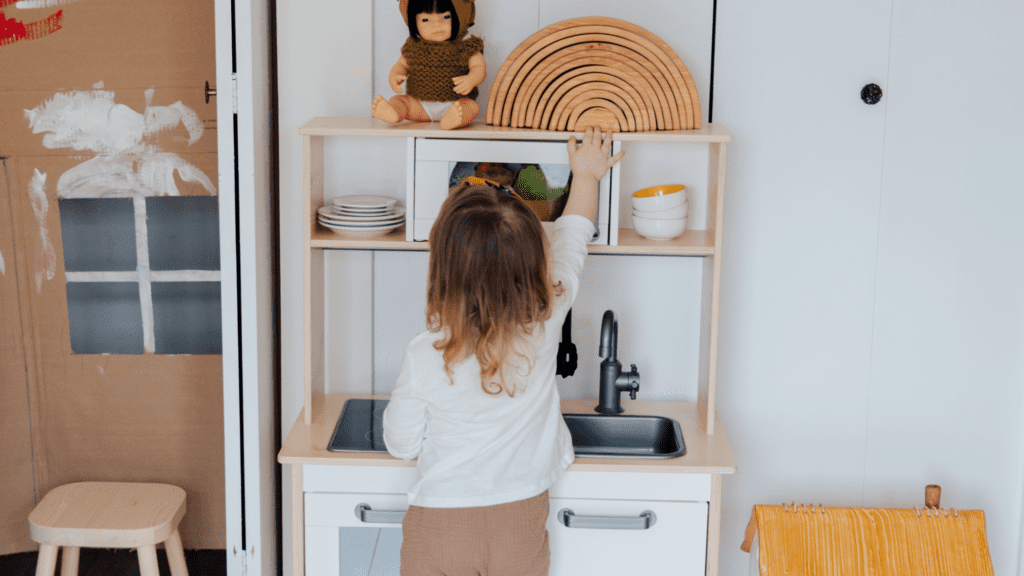Montessori is an educational philosophy for children from birth to age 18 that emphasizes freedom in learning, respect for the environment, and peace. Implementing Montessori principles at home is a great way to give your child a strong foundation for life.
Dr. Maria Montessori’s observations helped us understand how children learn in their environment. Montessori education promotes the development of healthy coping skills, encourages whole-body learning, and fosters self-reliance. Children learn best in an environment that allows them to grow naturally and freely.
Prerequisites of Setting Up Montessori at Home
Montessori preschools and kindergartens provide children with a warm, safe space that promotes harmony, security and development through play. The aim is to foster independence in the early years so that children will grow into productive members of society. This theory works by encouraging children to learn through play by providing them with a variety of interesting choices that are achievable and within their capabilities.
It believes practice comes from making mistakes and dealing with the consequences. Each child will be given a chance to try before they fail, giving them the opportunity to learn through trial and error. It is hence achieved via a positive atmosphere where children are encouraged to work at their own pace and at their own level of ability.
In the same way, Montessori environments at home are highly recommended not just when babies first start developing but also even years after that.
How to Set up Montessori at Home?
Many parents are interested in implementing Montessori principles in their homes but don’t know where to start. It begins with a shift in mindset. As a parent, the first thing you need to understand is that children, even the youngest ones, are capable of much more than you realize. Once you acknowledge this, you can make a few changes around your home to make the Montessori experience a success for both you and your child.
To set up a Montessori-inspired room at home, consider the type of learning that suits each room best. For example, if you plan to set up a room for a child who is still learning letters and numbers, you should place many blocks and other stacking materials on the floor. You might also want to consider using activities that require movement, such as having the child work with play-doh to produce art. For a child who is learning about colors, using many different colored crayons to color with would be helpful. Ask yourself the questions listed in the below section
Questions to Ask While Setting up Montessori at Home
What type of learning environment is it?
- Learning Material-What are the materials or tools you can use to support learning? Puzzles, building blocks, play-doh, and colored crayons.
- Activities – What activities might be helpful in this setting? Coloring, drawing, block-stacking, building with legos, building with blocks, play-doh, and puzzles.
- Learning Style-What sort of learning style is present here?
- Montessori -Prefers self-paced, active play and exploration, self-guided and organized learning, and hence prefers hands-on, in-person learning, discovery-based, and discovery play. or
- Preschool -Prefers exploration and child-paced, with more rules and structure in learning.
The ideal Montessori room for a child is a room with windows for ample natural light. It should have enough space to move around in while also offering things to explore and learn. It should be divided into two sections:
- [ ] Create a space for children to learn and play using activities
- [ ] Create a nook or library for children to read books or do quiet work
6 Ways to Incorporate Montessori Principles at Home
Here are a few ways to create a Montessori environment at home for your kid:
1. Organize Your Environment
Create a place for everything and everything in its place.
- A place for everything is one of the key principles of Montessori at home. It will be easy for your child to learn where everything belongs when you designate a place for everything.
- Having everything in its place is another essential tool to teach kids to take responsibility for their belongings and clean up their mess.
Thus, make things more accessible for your child. It means placing toys or activities on a shelf that is accessible to the child. By accessible, it means:
- easy to reach without adult intervention
- Visible to eyes to choose from.
2. Rotation of Toys and Activities
The Montessori approach also encourages parents to rotate their children’s toys and books regularly. These rotations are intended to keep their curiosity alive and prevent boredom.
Organizing shelves may seem overwhelming to some parents, but rotating items based on the seasons and your child’s current interests is the best way to go about it. The key is to promote creativity and exploration.
Ask yourself questions such as what they like. Do they get excited about dinosaurs or robots? Start with the things that interest them and place the activities/toys associated with them on the shelves.
3. Emphasize Life Skills
Young children can help around the house if they are given the opportunity. Teaching your child to be considerate and capable of handling their own space at an early age will prepare them to be considerate and capable adults in the future. Eventually, your child will be able to put their cups in the cabinet on their own, but their minds are so absorbent that it won’t take long to develop the ability.
Make sure their activities match their ability and age. For example, children with age 3-6 years can learn to water plants, feed pets, wipe the table after a meal and pick up their toys. While children aged 6-12 years can incorporate more complex tasks into their routines, such as taking out the trash, meal preparation, and basic home maintenance.
4. Concentration and patience
Most parents believe children are incapable of concentration. Children indeed cannot focus on something for the same length of time as adults. According to the Montessori pedagogy, your child can develop this skill from an early age. Want to know how?
Well, you can accomplish this by finding out what their interests are and providing them with the materials and space they need to pursue them.
5. Focus on Inner Motivation, Not Rewards
The Montessori method does not emphasize extrinsic rewards for good behavior, such as stickers or candy, or any other reward. It’s important to give verbal praise in moderation. However, learning something new or completing a task should prompt your children to feel a sense of pride and pleasure.
6. Having Materials that are Easy to Store
Yes, as you read, there is no need to buy expensive apparatus to teach your child the benefits of Montessori education. Look for pocket-friendly alternatives that serve the same purpose. For example, for bead bars, number rods, moveable alphabets, grammar symbols, sentence analysis materials, and many more, you can find printable versions of these materials at The Wisdom Nest.
Hurdles You Might Face while Setting up Montessori at Home
It is possible that you might encounter hurdles while setting up the Montessori environment at home, such as:
- Children are showing different reactions to the new setup.
- Whether children need more safety and protection.
- Children are getting overwhelmed with the amount of information to be learned.
- Whether the environment fulfills the development needs of children.
- Are children getting full attention?
However, with patience, determination, and a willingness to learn, these hurdles can be overcome to provide your child with the benefits of a Montessori environment at home. You can also find a few tips to make your life simple in the below section.
How to Prepare a Room just like Montessori Classroom?
To prepare your kid’s room the Montessori way, follow the below steps:
- Surfaces for cleaning tactile materials should be large handling containers should be free from lids or other security components or intricately shaped edges and never have pot handles.
- Use as many natural textures in a single area as possible; introduce echolalic games such as clapping, songs, look and find with images, etc.
- Make sure that they feel independent by providing supplies like child-sized dish brushes to prevent hand fatigue because the activity might make them sleepy later on in the day.
- Constantly provide a variety of interesting choices that are achievable and within their scope of development for activities like playing with different types of balls or exploring different textures and surfaces.
Conclusion
The benefits of Montessori education are numerous, but there are some basic things you can do to incorporate it into your home life. You don’t need special materials to do so. You can use whatever you have at home, such as opening and closing containers, buttons, locks, and transferring water and food items between containers. The possibilities are endless, and there is no need to follow a specific order when introducing practical skills.
The key is to introduce a variety of activities, let your child choose, and allow them to explore. Keep it simple with this mantra: follow your child’s lead.






